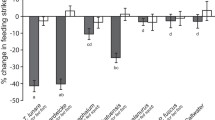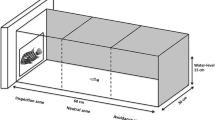Abstract
Despite the importance of acquired predator recognition in mediating predator–prey interactions, we know little about the specific characteristics that prey use to distinguish predators from non-predators. Recent experiments with mammals and fish indicate that some prey lacking innate predator recognition have the ability to display anti-predator responses upon their first encounter with those predators if they are similar to predators that the prey has recently learned to recognize. This phenomenon is referred to as generalization of predator recognition. In this experiment, we documented for the first time that larval amphibians (woodfrog, Rana sylvatica) have the ability to generalize the recognition of known predators to closely related novel predators. Moreover, we demonstrated that this ability is dependent on the level of risk associated with the known predator. When red-bellied newt, Cynops pyrrhogaster (known predator), was paired with simulated low risk, tadpoles displayed fright responses to newts and novel tiger salamanders, Ambystoma tigrinum, but not to novel African clawed frogs, Xenopus laevis. However, when the newt was paired with simulated high risk, tadpoles generalized their responses to both tiger salamanders and African clawed frogs. Larval anurans seem to have a wider generalization frame than other animals.


Similar content being viewed by others
References
Berejikian BA, Tezaka EP, LaRaeb AL (2003) Innate and enhanced predator recognition in hatchery-reared Chinook salmon. Environ Biol Fishes 67:241–251
Chivers DP, Mirza RS (2001) The importance of predator-diet cues in the responses of larval woodfrogs to fish and invertebrate predators. J Chem Ecol 27:45–51
Chivers DP, Smith RJF (1994a) Fathead minnows, Pimephales promelas, acquire predator recognition when alarm substance is associated with the sight of unfamiliar fish. Anim Behav 48:597–605
Chivers DP, Smith RJF (1994b) The role of experience and chemical alarm signalling in predator recognition by fathead minnows, Pimephales promelas. J Fish Biol 44:273–285
Chivers DP, Mirza RS, Bryer PJ, Kiesecker JM (2001) Threat-sensitive predator avoidance by slimy sculpins: understanding the importance of visual versus chemical information. Can J Zool 79:867–873
Dupuch A, Magnan P, Dill LM (2004) Sensitivity of northern redbelly dace, Phoxinus eos, to chemical alarm cues. Can J Zool 82:407–415
Fendt M (2006) Exposure to urine of canids and felids, but not of herbivores, induces defensive behavior in laboratory rats. J Chem Ecol 32:2617–2627
Ferrari MCO, Chivers DP (2008) Cultural learning of predators in mixed species assemblages: the effects of tutor-to-observer ratio. Anim Behav 75:1921–1925
Ferrari MCO, Trowell JJ, Brown GE, Chivers DP (2005) The role of leaning in the development of threat-sensitive predator avoidance in fathead minnows. Anim Behav 70:777–784
Ferrari MCO, Kapitania-Kwok T, Chivers DP (2006) The role of learning in the development of threat-sensitive predator avoidance: the use of predator cue concentration by fathead minnows. Behav Ecol Sociobiol 60:522–527
Ferrari MCO, Gonzalo A, Messier F, Chivers DP (2007a) Generalization of learned predator recognition: an experimental test and framework for future studies. Proc R Soc B 274:1853–1859
Ferrari MCO, Messier F, Chivers DP (2007b) First documentation of cultural transmission of predator recognition by larval amphibians. Ethology 113:621–627
Ferrari MCO, Messier F, Chivers DP (2007c) Degradation of alarm cues under natural conditions: risk assessment by larval amphibians. Chemoecology 17:263–266
Ferrari MCO, Messier F, Chivers DP (2008a) Can prey exhibit threat-sensitive generalization of predator recognition? Extending the Predator Recognition Continuum Hypothesis. Proc R Soc B 275:1811–1816
Ferrari MCO, Messier F, Chivers DP (2008b) Threat-sensitive learning by the larval mosquito Culex restuans. Behav Ecol Sociobiol 62:1079–1083
Griffin AS, Evans CS (2003) Social learning of antipredator behaviour in a marsupial. Anim Behav 66:485–492
Griffin AS, Evans CS, Blumstein DT (2001) Learning specificity in acquired predator recognition. Anim Behav 62:577–589
Guirlanda S, Enquist M (2003) A century of generalization. Anim Behav 66:15–36
Hazlett BA (2003) Predator recognition and learned irrelevance in the crayfish Orconectes virilis. Ethology 109:765–780
Helfman GS (1989) Threat-sensitive predator avoidance in damselfish–trumpetfish interactions. Behav Ecol Sociobiol 24:47–58
Herzog M, Hopf S (1984) Behavioural responses to species-specific warning calls in infant squirrel monkeys reared in social isolation. Am J Primatol 7:99–106
Kesavaraju B, Damal K, Juliano SA (2007) Threat-sensitive behavioral responses to concentrations of water-borne cues from predation. Ethology 113:199–206
Kiesecker JM, Blaustein AR (1997) Population differences in responses of red-legged frogs (Rana aurora) to introduced bullfrogs (Rana catesbeiana). Ecology 78:1753–1760
Mathis A, Smith RJF (1993) Fathead minnows, Pimephales promelas, learn to recognize northern pike, Esox lucius, as predators on the basis of chemical stimuli from minnows in the pike's diet. Anim Behav 46:645–656
Mathis A, Chivers DP, Smith RJF (1996) Cultural transmission of predator recognition in fishes: intraspecific and interspecific learning. Anim Behav 51:185–201
Mineka S, Cook M (1988) Social learning and the acquisition of snake fear in monkeys. In: Zentall TR, BGJr G (eds) Social learning: psychological and biological perspectives. Erlbaum, Hillsdale, pp 51–73
Mirza RS, Ferrari MCO, Kiesecker JM, Chivers DP (2006) Responses of American toad tadpoles to predation cues: behavioural response thresholds, threat-sensitivity and acquired predation recognition. Behaviour 143:887–889
Rescorla RA, Wagner AR (1972) A theory of Pavlovian conditioning: Variations in the effectiveness of reinforcement and nonreinforcement. In Black AH, Prokasy WF (eds), Classical Conditioning II. Appleton-Century-Crofts, pp. 64–99
Stankowich T, Coss RG (2007) The re-emergence of felid camouflage with the decay of predator recognition in deer under relaxed selection. Proc R Soc B 274:175–182
Stephens DW (1991) Change, regularity and value in the evolution of animal learning. Behav Ecol 2:77–89
Vieth W, Curio E, Ernst U (1980) The adaptive significance of avian mobbing. III. Cultural transmission of enemy recognition in blackbirds: cross-species tutoring and properties of learning. Anim Behav 28:1217–1229
Wisenden BD, Millard MC (2001) Aquatic flatworms use chemical cues from injured conspecifics to assess predation risk and to associate risk with novel cues. Anim Behav 62:761–766
Woody DR, Mathis A (1998) Acquired recognition of chemical stimuli from an unfamiliar predator: associative learning by adult newts, Notophthalmus viridescens. Copeia 1998:1027–1031
Acknowledgements
We thank Peter Bednekoff and the anonymous reviewers for their constructive comments on our manuscript. We thank Jean and Glen Chivers for their help and support and for letting us invade their home and wetlands for the duration of our field season. We thank the Biology Department of the U of S for providing the predators. Research funding was provided to F. Messier and D. Chivers through the Natural Sciences and Engineering Research Council of Canada. All work reported was in accordance with the Animal Care Committee Protocol # 20060014 from University of Saskatchewan.
Author information
Authors and Affiliations
Corresponding author
Additional information
Communicated by P. Bednekoff
Rights and permissions
About this article
Cite this article
Ferrari, M.C.O., Brown, G.E., Messier, F. et al. Threat-sensitive generalization of predator recognition by larval amphibians. Behav Ecol Sociobiol 63, 1369–1375 (2009). https://doi.org/10.1007/s00265-009-0779-5
Received:
Revised:
Accepted:
Published:
Issue Date:
DOI: https://doi.org/10.1007/s00265-009-0779-5




